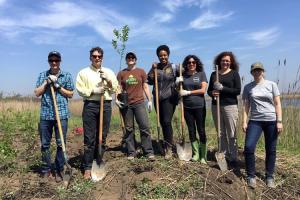Human Dimensions
Many decisions in natural resource management involve complex trade-offs that affect people, communities, and ecosystems differently. The Human Dimensions program strives to generate relevant and actionable science that integrates the social, economic, and ecological dimensions of resource management and planning to help us thoughtfully address these challenges at the intersection of people and the environment. Broadly, our research examines ways people relate to the environment and make land management decisions, and how land management activities affect our ecosystems, landscapes, and communities. When applied to management, this feedback enables more sustainable outcomes.

Members of the USFS Roosevelt Hotshot Crew taking a look, Roosevelt NF, 2013.
Human Dimensions Research at RMRS
The Human Dimensions program consists of research scientists, professionals, and specialists with a range of disciplinary expertise, including social sciences, economics, ecology, forestry, and data and decision sciences. We collaborate with researchers from other RMRS science programs, Forest Service research stations, and universities nationwide; we work closely with partners in the National Forest System and State, Private, and Tribal Deputy Areas; and we work with NGOs, Tribal Nations, and local communities to co-develop research, tools, and products that support safe and resilient land and resource management.
Our researchers and staff are stationed primarily in Colorado and Montana. While our program focuses on pressing issues in the Intermountain West, much of our research and many of our tools and products serve land managers across the nation and internationally.
Human Dimensions science at RMRS includes research in the following topic areas.
Fire Management and Risk Mitigation
- Management strategies to convert forested landscapes back to a fire resilient condition while protecting workforce and community safety.
- Incorporation of data, risk, and decision science into natural resource planning and management.
- Development and application of risk analytics, decision support tools, and collaborative processes for fuels management, wildfire planning, and wildfire incident response.
Related topics:
Fire Safe and Effective Response Fuels Prescribed Fire Managing the Land
Social Impacts of Wildfire and Wildfire Mitigation
- Effectiveness of the wildland fire management system, including safety during operations, job satisfaction and workforce well-being, and organizational learning.
- Measurement of non-market economic aspects of wildfire, for example, the costs associated with exposure to wildfire smoke.
- Community wildfire risk, including private landholder perceptions, parcel- and community-level risk assessment, wildfire mitigation education, and preparedness.
- Wildfire communication.
Related topics:
Environment and People Fire Safe and Effective Response
Forest Products, Ecosystem Services, and Nature-Based Solutions
- Forest product use and development; for example, social and economic aspects of biomass utilization and biochar production.
- Valuation of ecosystem services and their role in economic and community development and forest planning; for example, understanding the role forests and grasslands play in providing safe clean water as an ecosystem service, and the effects of climate change on water supply and demand.
- Urban access to heat-protective infrastructure and public lands; for example, research about geographic distribution of urban heat islands and recreation research about trends across race and ethnicity and programs that connect urban youth to wilderness areas.
- Rangeland management: Use of models, remote sensing, and GIS to understand how issues like climate change affect rangelands, and development of decision support tools for rangeland managers.
Related topics:
Forest Products Biochar Range Management and Grazing Forest Management Environment and People Climate Change
Centers and Groups Led by Human Dimensions Researchers
-
Center or GroupStation
-
Center or GroupStation
-
Center or GroupStation
-
Center or GroupStation
Fire Management and Risk Mitigation
-
ProjectStation
-
ProjectStation
-
ProjectStation
-
ProjectStation
-
Project
Improved decision support for allocating landscape scale targeted grazing for reducing wildfire risk
Station -
ProjectStation
-
ProjectStation
-
ProjectStation
Wildfire Social Science
-
ProjectStation
-
ProjectStation
-
Project
-
ProjectStation
-
Project
-
ProjectStation
-
ProjectStation
Ecosystem Services and Nature-Based Solutions
-
ProjectStation
-
Project
-
ProjectStation
-
Project
Improved decision support for allocating landscape scale targeted grazing for reducing wildfire risk
Station
Data and Tools
- Tool
- Tool
- Dashboard
- Decision Support System
- Model
- Tool
- Model
- Decision Support System
- Tool
- Decision Support System
- Dataset
- Dashboard
- Dataset
Meet Our Scientists
- Video
- Video
- Video
- Video
- Video
- Video
- Video
- Video
Webinars
- Webinars
- Webinars
- Webinars
- Webinars
- Webinars
- Webinars
A West-Wide Rangeland Fuel Assessment: Reading the Tea Leaves
In episodes of Reading the Tea Leaves, Human Dimensions researcher Matt Reeves analyzes current rangeland fuel conditions across the U.S. West, with emphasis on emerging hotspots. New episodes are posted each month throughout the summer, sometimes more frequently as the wildfire season progresses.





































